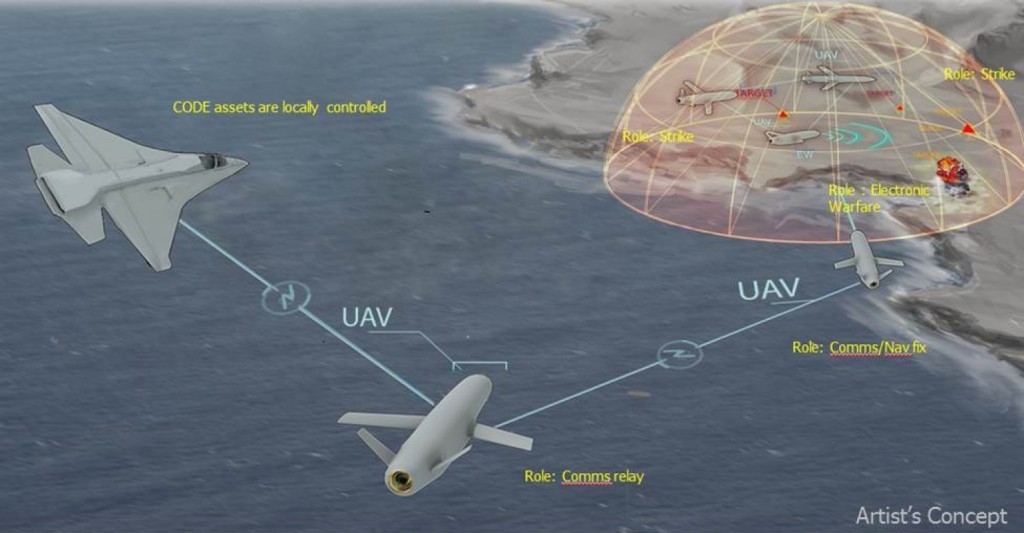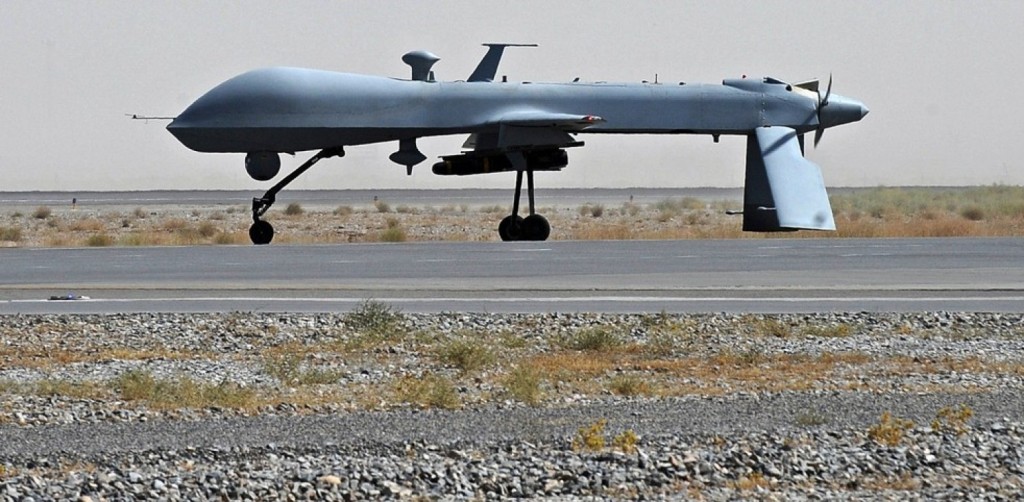Pentagon Agency Wants Drones to Hunt in Packs, like Wolves
MILITARISM, 26 Jan 2015
Dan Lamothe – The Washington Post

The Defense Advanced Research Projects Agency released this artist’s rendering to help explain what its Collaborative Operations in Denied Environment (CODE) program could do. (DARPA image)
23 Jan 2015 – The U.S. military is preparing for a series of meetings that could shake up how the Pentagon flies its fleet of drone aircraft and move them toward hunting together in packs.
The Defense Advanced Research Projects Agency will host the gatherings in March for its Collaborative Operations in Denied Environment (CODE) program, it said this week. The major emphasis: Figuring out a way to move free of having a pilot operate only one drone with assistance from a sensor operator and a team of intelligence analysts through satellite links.
“Just as wolves hunt in coordinated packs with minimal communication, multiple CODE-enabled unmanned aircraft would collaborate to find, track, identify and engage targets, all under the command of a single human mission supervisor,” said Jean-Charles Ledé, the program’s manager, in a statement.
DARPA officials said the CODE program would use a combination of software and algorithms to “extend the mission capabilities of existing unmanned aircraft well beyond the current state-of-the-art.” It also would allow drones to operate in areas in which electronic warfare might be used against them or they might be shot down, officials said.
A “Proposer’s Day” for the CODE program was held in April. In an explanation provided beforehand, DARPA officials said that while military drones have been successful over the last 25 years, the current systems would be vulnerable in the future.
Among the goals: Develop the ability for one mission commander to control numerous drones at one time, develop flexibility so drones in an area can communicate and protect each other, and geo-locating possible targets with powerful sensors and guiding less capable systems within their own ranges.
_______________________________
Dan Lamothe covers national security for The Washington Post and anchors its military blog, Checkpoint.
Go to Original – washingtonpost.com
DISCLAIMER: The statements, views and opinions expressed in pieces republished here are solely those of the authors and do not necessarily represent those of TMS. In accordance with title 17 U.S.C. section 107, this material is distributed without profit to those who have expressed a prior interest in receiving the included information for research and educational purposes. TMS has no affiliation whatsoever with the originator of this article nor is TMS endorsed or sponsored by the originator. “GO TO ORIGINAL” links are provided as a convenience to our readers and allow for verification of authenticity. However, as originating pages are often updated by their originating host sites, the versions posted may not match the versions our readers view when clicking the “GO TO ORIGINAL” links. This site contains copyrighted material the use of which has not always been specifically authorized by the copyright owner. We are making such material available in our efforts to advance understanding of environmental, political, human rights, economic, democracy, scientific, and social justice issues, etc. We believe this constitutes a ‘fair use’ of any such copyrighted material as provided for in section 107 of the US Copyright Law. In accordance with Title 17 U.S.C. Section 107, the material on this site is distributed without profit to those who have expressed a prior interest in receiving the included information for research and educational purposes. For more information go to: http://www.law.cornell.edu/uscode/17/107.shtml. If you wish to use copyrighted material from this site for purposes of your own that go beyond ‘fair use’, you must obtain permission from the copyright owner.
